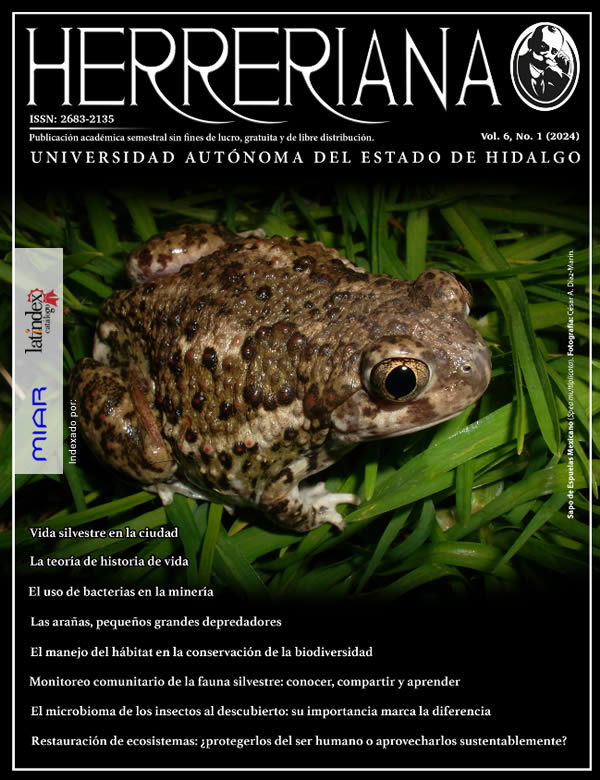La teoría de historia de vida
DOI:
https://doi.org/10.29057/h.v6i1.12011Palabras clave:
selección, adaptación, adecuación, compromisosResumen
Como parte de la biología evolutiva, la teoría de historia de vida permite estudiar la variación en las estrategias de historia de vida que presentan los seres vivos. Esta se basa en la idea de que al tener limitaciones energéticas, genéticas y fisiológicas, los organismos se enfrentan compromisos que a lo largo del tiempo van a moldear las características que conforman sus estrategias de vida. Las características de historia de vida varían ampliamente entre los organismos y son aquellas que se relacionan con los patrones de crecimiento, la supervivencia y la reproducción de los individuos, afectando su adecuación y la dinámica de las poblaciones de las que forman parte.
Descargas
Información de Publicación
Perfiles de revisores N/D
Declaraciones del autor
Indexado en
- Sociedad académica
- N/D
- Editora:
- Universidad Autónoma del Estado de Hidalgo
Citas
Burger, J. R., Hou, C., y Brown, J. H. (2019). Toward a metabolic theory of life history. Proceedings of the National Academy of Sciences, 116(52), 26653-26661.https://doi.org/10.1073/pnas.1907702116
Dunham, A. E., Miles, D. B., y Reznic, D. N. (1988). Life history patterns in squamate reptiles. In C. Gans, y R. B. Huey (Eds.), Biology of the Reptilia: Ecology B: Defense and life history (pp. 441-522). New York: A. R. Liss.
Gadgil, M., y Solbrig, O. T. (1972). The concept of r- and K-Selection: Evidence from wild flowers and some theoretical considerations. The American Naturalist, 106(947), 14-30. https://doi.org/10.1086/282748
Marshall, D. J., Bonduriansky, R., y Bussière, L. F. (2008). Offspring size variation within broods as a bet‐hedging strategy in unpredictable environments. Ecology, 89(9), 2506-2517. https://doi.org/10.1890/07-0267.1
MacArthur, R. H., y Wilson, E. O. (1967). The theory of island biogeography. Princeton University Press.
Miles, D. B., y Dunham, A. E. (1993). Historical perspectives in ecology and evolutionary biology: The use of phylogenetic comparative method. Annual Review of Ecology and Systematics, 24(1993), 587-619. https://doi.org/10.1146/annurev.es.24.110193.003103
Olofsson, H., Ripa, J., y Jonzén N. (2009). Bet-hedging as an evolutionary game: the trade-off between egg size and number. Proceedings of the Royal Society B: Biological Sciences, 276, 2963–2969. https://doi.org/10.1098/rspb.2009.
Ord, T. J., Blumstein, D. T., y Evans, C. S. (2002). Ecology and signal evolution in lizards. Biological Journal of Linnean Society, 77, 127-148. https://doi.org/10.1046/j.1095-8312.2002.00100.x
Pianka, E. (1970). On r- and K- Selection. The American Naturalist, 102, 592-597.
Promislov, D. E. L., y Harvey, P. H. (1990). Living fast and dying young: A comparative analysis of the life-history variation among mammals. Journal of Zoology, 220, 417-437. https://doi.org/10.1111/j.1469-7998.1990.tb04316.x
Sæther, B. E., Visser, M. E., Grøtan, V., y Engen, S. (2016). Evidence for r- and K-selection in a wild bird population: A reciprocal link between ecology and evolution. Proceedings of the Royal Society B: Biological Sciences, 2832015241120152411. https://doi.org/10.1098/rspb.2015.2411
Shine, R. (2005). Life-History evolution in reptiles. Annual Review of Ecology, Evolution and Systematics, 36, 23-46. https://doi.org/10.1146/annurev.ecolsys.36.102003.152631
Slatkin, M. (1974). Hedgings One´s evolutionary bets. Nature, 250, 704-705.
Sousa, T., Domingos, T., y Kooijman, S. A. L. M. (2008). From empirical patterns to theory: a formal metabolic theory of life. Philosophical Transactions of the Royal Society B: Biological Sciences, 363(1502), 2453-2464. https://doi.org/10.1098/rstb.2007.2230
Stearns, S. C. (1992). The evolution of life histories. Oxford University Press.
Winemiller, K. O. (2005). Life history strategies, population regulation, and implications for fisheries management. Canadian Journal of Fisheries and Aquatic Sciences, 62(4), 872-885. https://doi.org/10.1139/f05-040
Winger, B. M., y Pegan, T. M. (2021). Migration distance is a fundamental axis of the slow-fast continuum of life history in boreal birds. The Auk, 138(4), ukab043. https://doi.org/10.1093/ornithology/ukab043


















